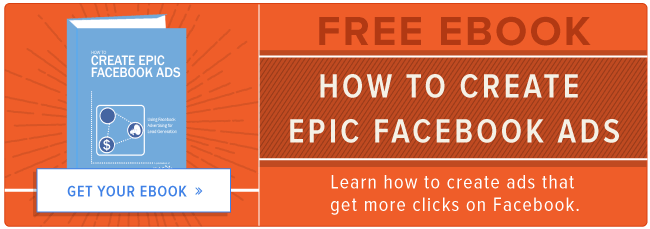It's a topic that is running rampant around the web. How do you measure ROI from Facebook? Is anyone (besides Fortune 500 brands with multi-million dollar budgets) generating ROI from Facebook? And if so, how?
The difficulty with establishing ROI on Facebook has typically been tracking, but luckily, Facebook recently made a bunch of updates to help marketers tackle this problem. And while Facebook is heading in the right direction, SMB marketers (and all marketers) need more, and they need it now.
So what’s the best way to track Facebook ROI? You're about to find out. This post will show you how to determine whether your Facebook ad spend is generating you the kind of ROI you need to justify the expense.
How to Measure the ROI of Your Facebook Ads
In order to determine the ROI of your Facebook ad spend, you first need to be able to properly track your Facebook connections. You can attract connections on Facebook two ways: by running paid ads, or by posting updates to your business page. If you're posting updates to your fan base, running ads to grow your audience via cost per connection campaigns is often difficult to measure. Necessary data that Facebook provides to properly track includes:
- Spend
- Clicks
- Connections
- Cost per click
But even with this data that Facebook provides, you still need a tracking solution that tells you your cost per connection. You could calculate that manually using data from Facebook by taking your spend and dividing it by your number of connections. But since we like to do things more efficiently here at HubSpot, we use a Facebook ads tracking app that easily allows you to see all of the metrics that are available within the Facebook user interface, and also provides you with that crucial cost per connection data. This is a time saving feature that allows marketers to quickly see which campaigns are cost effective, and which ones need work.

Now that you have that cost per connection data, it's time to start promoting your offers! You know, so you can turn those connections into leads. As you promote your offers to your audience, it's imperative to be able to track who converts into a lead, so be sure to use landing pages that are integrated with your closed-loop analytics software. When we do this with HubSpot, for example, we can see all of the leads that were driven by Facebook with the following lead information:
- Date
- Event trigger
- Lead source
- Contact information
- Lead quality
- Sales details

Now, we can understand which campaigns and segments are more interested in our offerings, and as leads turn to sales, ROI is easily realized with every new customer. And all of that information lives within your marketing software for your sales and marketing team to reference!
To make all of this a little clearer, let's use an example of how one might establish the ROI of a Facebook ad. We'll use an example from one of our own campaigns.
Step 1: Create a Facebook ad that includes a lead generating offer. If you need helping creating a Facebook ad, reference this ebook for some assistance!

Step 2: Send users to a unique landing page so they can redeem the offer in your ad. Remember, this is how you'll turn those Facebook connections into leads! And of course, we've written a handy guide to creating an effective landing page.

Step 3: For the sake of this example, we'll assume the visitor converted on the landing page. The next step is to analyze the data.

Again, we use the HubSpot Facebook ads app to do our analyzing, though you can get the data from a combination of Facebook ad analytics and your own closed-loop marketing software. But regardless of which tool you use, you should look at the following data points to track your lead generation campaigns over time:
- Spend
- Clicks
- Leads
- Cost per lead
- Customers
- Cost per customer
With this additional data readily available, measuring ROI is easy, because it puts direct spend up against revenue generated to truly measure ROI on Facebook.
Trying to track ROI from social media can be a nightmare, especially if you aren't using the proper tools. Tracking, cost association, and revenue measurement are paramount when it comes to driving new business with Facebook. Without having the ability to do those things, the time you do spend on Facebook will become a cyclical headache that just won't go away.
How do you determine the ROI of your Facebook ad spend?





![Anatomy of a Facebook Ad: How to Create Scroll-Stopping Campaigns [+ Examples]](https://53.fs1.hubspotusercontent-na1.net/hubfs/53/anatomy-of-a-fb-ad.png)



.jpg)
![What Is Facebook CBO? Budget Optimization Done Right [Tutorial]](https://53.fs1.hubspotusercontent-na1.net/hubfs/53/facebook-cbo.jpg)
